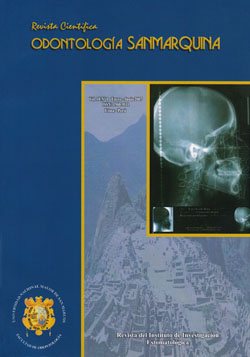Clinical use of mineral trioxide aggregate (MTA) in periapical lesions and the treatment of root perforations
DOI:
https://doi.org/10.15381/os.v10i1.2923Keywords:
MTA, apicectomy, rooth perforation treatment.Abstract
The use of MTA cement (mineral trioxide aggregate) to solve endodontics treatment complications, like pulpar floor camera perforations during root canal treatment, as well as a retrograde obturation material of apicectomy treatment, was the purpose of this investigation. White MTA Angelus, (Industria de productos odontologicos Ltda. Londrina-PR-Brazil) was used wich has 10 – 15 minutes as initial and final hardening time. The radiopacity showed by the material was somewhat superior to that of the dentine and oseo tissues, making its visualization in control x-rays easier. Inmediate and sixty days postoperative radiographic and clinical controls were made to cases. The results showed that there was adaptation from the cement to the retroapical and perforation cavity walls, producing an apical and marginal seal. The tricalcic silicate, tricalcic aluminate, dicalcic silicate, and tetracalcic ferric aluminate were the cement constituent elements; these allowed a stimulation of scaring and repair of the surrounding tissues that evolved in a favorable form until the moment of the last control was carried out in this investigation.Downloads
Downloads
Published
Issue
Section
License
Copyright (c) 2007 Martha Elena Pineda Mejía, Manuel Silva Infantes, Doris Salcedo Moncada, Antonia Castro Rodríguez, Liliana Terán Casafranca, Eduardo Ortiz Cárdenas, Julio Ochoa Tataje, Jorge Gaitán Velásquez, Romel Watanabe Velásquez

This work is licensed under a Creative Commons Attribution-NonCommercial-ShareAlike 4.0 International License.
AUTHORS RETAIN THEIR RIGHTS:
a. Authors retain their trade mark rights and patent, and also on any process or procedure described in the article.
b. Authors retain their right to share, copy, distribute, perform and publicly communicate their article (eg, to place their article in an institutional repository or publish it in a book), with an acknowledgment of its initial publication in the Odontología Sanmarquina.
c. Authors retain theirs right to make a subsequent publication of their work, to use the article or any part thereof (eg a compilation of his papers, lecture notes, thesis, or a book), always indicating the source of publication (the originator of the work, journal, volume, number and date).






